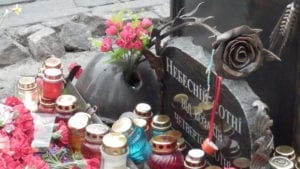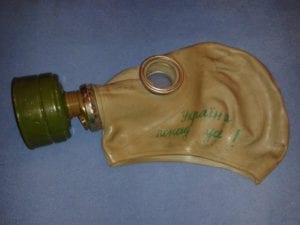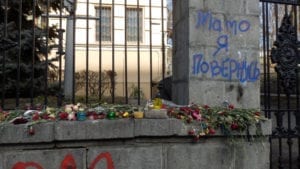Olena Kagui
Rhode Island, United States

Photo by Olena Kagui, taken March 17th, 2014. Source
There was no physical blood present when I stepped onto Maidan Square in Kyiv, Ukraine. Yet signs of it were everywhere. Bullet holes pierced the shields and helmets that memorialized the fallen. Flowers, the color of blood, sat inside the cavern of the helmet. The space, once occupied by a human mind, was now an empty vase sheltering plastic flowers that will never wilt.
The Red Cross was an integral part of providing aid to those injured and displaced during Ukraine’s bloody revolution. What began as a peaceful protest in November 2013 turned violent in February 2014. According to the Ministry of Healthcare in Ukraine, five days of violence resulted in 113 deaths and 1,811 injuries. There were almost a million protesters in Kyiv during this time. Many chose to stay at Maidan indefinitely, setting up camps where they slept, lived, and kept the protest alive.
Field hospitals popped up to treat the wounded. Soup kitchens opened to feed the hungry. Volunteers appeared to help where it was needed. An entire society was born out of necessity, powered by a mutual cause. Once strangers, people became family. They did not share blood, but their bond was created because of that which was spilled.
While Ukrainian blood flows through my veins, I was raised in a different country and speak predominantly other languages. My mother stood on the frontlines of Maidan Square in her home city. I joined her later, visiting my birth city to report on the situation that was still clouded with rumors and mystery.

The text says “Ukraine, above all.” It is part of a patriotic phrase. Photo taken by Olena Kagui on March 17th, 2014. Source
The media showed a city on fire. They described the violence, the anger, and the political chaos of the revolution. I decided to focus instead on those cleaning up the blood. The only fire I saw during my visit was in people’s eyes. The community welcomed me with my accented Ukrainian and my low-tech camera. They hugged me, kissed me, and told me their stories.
I spent several hours in one of the field hospitals in the very center of Maidan. I spoke to several nurses there, but mainly Iryna Zakharchenko and Olga Azzuz. They pointed out the nurse who treated the first victim of the protests, an Armenian boy. Azzuz describes what happened in Kiev as “the scream of the soul of the nation.”
They had treated more than one hundred patients a day. Ninety percent of the protesters suffered from bronchitis after breathing in dangerous fumes from the gas weapons. The doctors and nurses at the hospital helped everyone who was injured, whether protester or visitor. “What about Berkut?” I asked about the riot police. A dark expression came over her face. “We would help everyone, Berkut too . . . but usually as a trade for them letting someone go,” she said.
Olga Azzuz volunteered there as a dentist. “My soul called me to work here,” she said. In the beginning they were not allowed to come to Maidan during regular work hours, so she would come after work, bringing food and clothes. Once the shooting began, Kyiv was closed and a field hospital was set up. She often brought her nineteen-year-old son with her, because he would tell her, “If you don’t take me with you, I’ll come on my own.”
While interviewing Azzuz and Zakharchenko, another nurse brought me a “souvenir.” I expected a flag or a badge. Instead, I was handed a used gas mask.

Graffiti that says “mom, I will return.” Photo taken by Olena Kagui on March 16th, 2014. Source
The Red Cross had a huge impact on protestors’ health and safety. First aid teams assisted people in -20°C temperatures. They treated immediate wounds and had their own tent that welcomed anyone who was injured. Fortunately, members of the Red Cross had slightly more immunity than volunteer medics: they were equally at risk from the violence but had some leeway for transporting patients once they were out of the fighting zones.
Many illegal and dangerous weapons were used in the fighting, and people suffered serious injuries. Azzuz explained that the medical locations had to be moved frequently to stay safe from Berkut. One time they had just finished tending to a group of injured protesters when someone ran in and told them that Berkut was on their way. They put people on stretchers and used the Red Cross logo to protect themselves and find shelter. Some people could barely walk and many roads were blocked. A Polish church offered to take them in but the road to the church was blocked. They ended up walking in a random direction that had no blockades and ran into a group of strangers who had cars. They drove the injured to official hospitals nearby.
While this event took place six years ago, the violence never ended. Maidan is once again free of protesters, discarded shields, and barricades. Instead there are flowers and memorials for those who lost their lives. But outside of Kyiv, in the eastern part of the country, war continues. The Red Cross continues to help those in need across the country. Volunteers continue to risk their lives fighting for freedom. Blood continues to be spilled on both sides.
OLENA KAGUI is a Ukrainian born Czech living in Rhode Island, USA. Olena is an aspiring writer who has won an excellence award for her piece on abortion for the Prague Freedom Foundation. In 2014 she received a grant to report on the situation in Ukraine from Kyiv. Afterwards, she organized a charity photo auction together with the Organization for Aid to Refugees, raising money to buy baby carriages for refugee mothers living in Prague. Olena continues to blog and write about travel, entomophagy, and the environment while dabbling in fictional writing.
Submitted for the 2019–2020 Blood Writing Contest

Leave a Reply